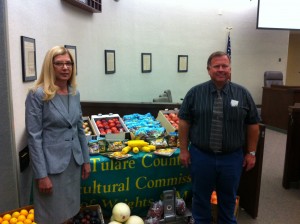
Commissioner Tom Tucker before the July 23 Tulare County Board of Supervisors meeting.
The dairy industry, while still the county’s dominant ag industry, didn’t fare as well, however. In 2011, the county had a value of more than $2 billion in milk and milk production. This decreased by about 10% to $1.8 billion last year.
“We’re very pleased with the report and happy to see the turnaround in the last few years,” said Kinoshita after the meeting. “I think it’s great news for the local economy. We would have liked to see our dairy industry do better. We want to see the business maintain so that the side businesses do well.”
She referred to a study showed that for every four cows in the county, 200 jobs are created in such industries as ice cream, cheese and fertilizer.
The top ten ag products in Tulare County last year were (in order of value): milk, grapes, oranges (navel and valencia), cattle and calves, corn (grain and silage), alfalfa (hay and silage), pistachio nuts, almonds (meats and hulls), walnuts, and peaches (cling and freestone).
The 2012 Tulare County Agricultural Crop and Livestock Report puts the county at number two in the state with a crop and livestock value of a little over $6.21 billion. Fresno leads the state with $6.58 billion. Kern County has not placed its report on its supervisors’ agenda yet, but the county usually is third in the state in crop and livestock value.
“The report is always a great tool for us to use in our outreach,” said Tricia Stever Blattler, executive director of the Tulare County Farm Bureau, who noted that while the report reflects growth, productivity and crop value, it doesn’t include the costs faced by those in the ag industry.
“Livestock production has really struggled with the feed cost and the regulatory overhead,” she said, adding that the profit margin was “significantly smaller” in 2012 than in previous years.
“Grapes had a phenomenal year with a $330 million increase over last year’s value,” Kinoshita said. “Grapes are usually in the third or fourth spot. The price of (grape) juice just happens to be very strong. There was good table grape production. Raisin prices were very good. It was just a perfect year.”
She estimated that table grape production was five tons higher per acre in 2012 than in 2011, and that tons per acre for raisins also increased over 2011. “We don’t necessarily hear the reason why,” she said. “It’s probably not just one particular reason.”
“I was surprised that grapes had such a banner year,” said Stever. “I didn’t expect them to jump to number two, over citrus.”
Walnut and grain values have remained constant for years and pistachios and almonds caught up, according to the report. “We have some dairymen who have diversified and planted pistachios and almonds,” Kinoshita explained. “There has been a lot of advertising for the health benefits of nuts, especially almonds and walnuts. Corporate growers of pistachios, like Paramount Farming, have had very successful pistachio campaigns.”
Oranges were still the county’s main fruit and nut export with more than 51% of foreign sales. Grapes were second with almost 24%. Tangelos and tangerines were a distant third with less than 5%.
“We are the leading exporter in the state,” said Kinoshita, noting that 34 million cartons of fruits and nuts were exported from Tulare County in 2012. “We’re ground zero for citrus production and table grapes. A lot of fruit from other counties comes into Tulare County. Our (export) fees are less expensive than surrounding counties. We have 61 citrus packing sheds.” For comparison, she noted that Fresno County has 19 and Kern County has 10.
The report is available in PDF format at http://agcomm.co.tulare.ca.us.
